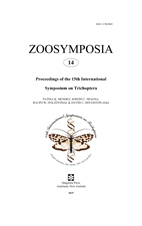Abstract
A considerable number of insect species, including Trichoptera, are described from a single specimen, also known as a 'unique' or a 'singleton'. We ask the question of whether this reflects failure to consider variation and related species, lack of collecting effort, or true rarity. In an attempt to answer this question we examine the available literature and data on the Trichoptera of Tasmania and New Caledonia. We note a low level of taxonomic synonymy among species in these faunas. Moreover, a significant proportion of species from Tasmania that were based originally on singletons have been re-collected subsequently, but this is not true for New Caledonia. The possible significance of these figures is considered following examination of data on diversity and abundance of Hydroptilidae collected by regular, standardised light trapping over almost two years at a northern Australian tropical stream. We conclude that quite a large proportion of the Trichoptera species based on singletons are rare, valid species, but for others the appearance of rarity may be a consequence of inadequate collecting, particular behavioural attributes of the species, including seasonality, and failure to consider fully the structural diversity of related species. Lastly, we discuss briefly the consequences of rarity, apparent or real, on conservation management.

